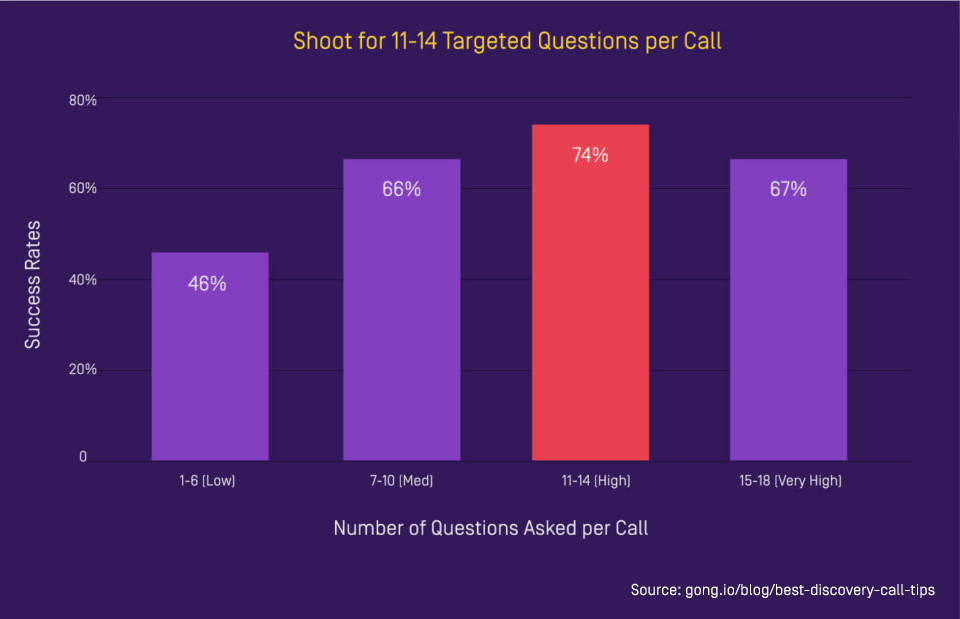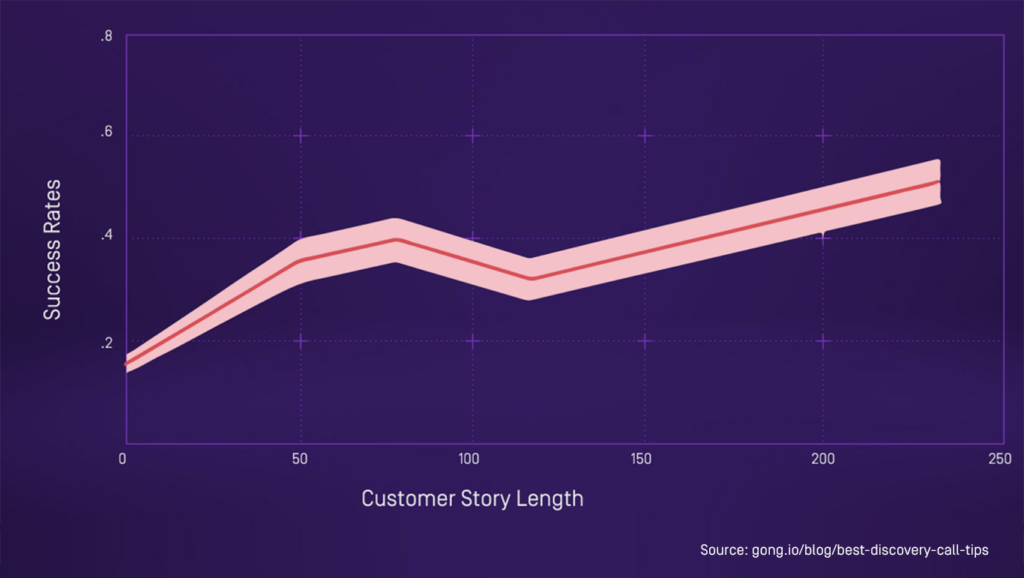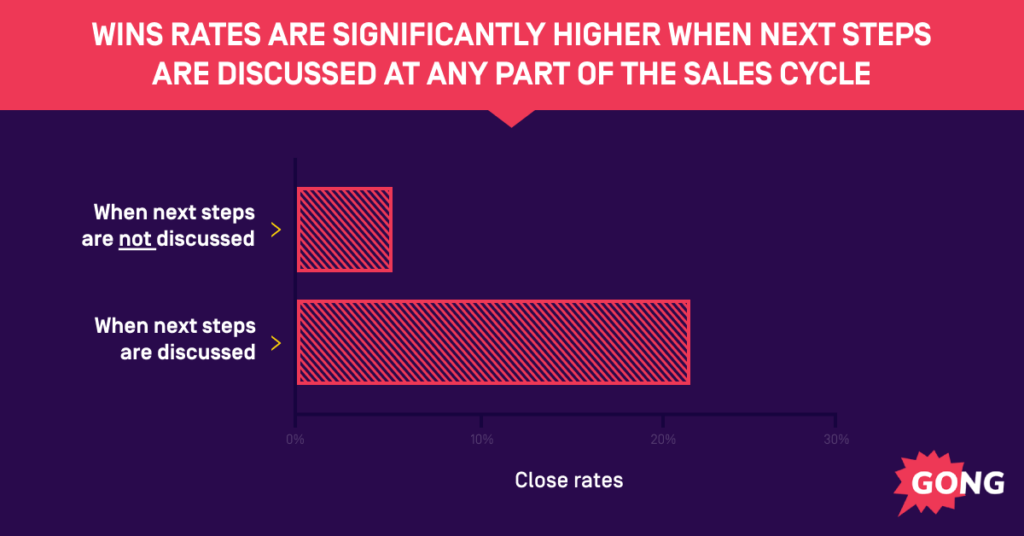12 sales discovery questions that pinpoint pain and clarify solutions

The best reps ask the best questions.
Asking questions is good for your brand and your career, according to this Forbes article. “The research shows that asking more questions builds emotional intelligence.”
It turns out, asking (more, better) questions also translates well to the most successful reps.
Ask questions, yes, but know where the sweet spot is, especially when it comes to questions during a discovery call.
Too many sales discovery questions (15+), and you are running an interrogation. Too few, and you’re unlikely to unearth what matters – pain points.
Aim for between 11 and 14 targeted questions per call:

Note: this same recommendation does not hold when selling to a C-Suite executive, who generally have less patience for a barrage of questions. Read The 11 Best Discovery Call Tips For Sales You’ll Read This Year for the full story (see Tip #9).
Additionally, be sure to meet your prospect where they stand by matching your sales questions to the buyer’s journey.
Your first few discovery questions for sales should respect your prospect’s stage in the buying journey.

I see this mistake all the time.
A BDR will “follow the script” and ask, What’s your biggest strategic priority for this year? … when the buyer is already actively looking at products like yours – not the time for a diagnostic question, one that is asked to uncover pain.
Leading with a diagnostic question when a buyer is not in that stage is annoying and won’t get you very far in the building trust and rapport category.
Alright. Now that we’ve covered the basics, let’s look at several sales discovery questions that help pinpoint real buyer pain.
Sales discovery questions to ask for “Latent Pain”
Latent pain. The first stage of the buyer’s journey. The top of the funnel, if you will.
The buyer is aware they have a problem but is not quite ready to do anything about it. Said another way, their business challenge is an annoyance, but not something worth investing time/resources/money into … yet.
There is little to no active search for a solution in the latent pain stage of the buyer’s journey.
Think back burner.
During this stage, a question like “What do you hope to achieve by implementing a solution?” often plays well. It’s frictionless. It’s what they want to (or are willing to) talk about.
When considering latent pain questions, your goal is to uncover a potential fit between your buyer’s priorities and your solution.
This is where “you” questions come into play – tying your solution to the buyer’s current initiatives. Questions such as:
- What’s your biggest strategic priority for this year?
- What initiatives are you rolling out as part of your plan?
- Where are you in the process?
Sales discovery questions to ask for “Active Pain”
After you’ve moved through the latent pain stage, it’s time to jump into the buyer’s active pain – the second phase of the journey.
Note: It’s also entirely possible – even likely – a buyer will ENTER the funnel at this stage. Inbound leads – demo form fills, sales inquiries, chatbot “I’d like to speak with a sales rep” replies, and so on.
A buyer in the active pain stage has an evident, well-defined pain. They know something is broken and/or could be improved. They are actively seeking out a solution to that pain. They are … hurting and have already accepted they have a challenge worth solving.
During the active pain stage, it’s all about diagnostic questions. You are the “sales doctor,” if you will. Your job is to evaluate the patient … err, buyer … uncover their symptoms, offer current fixes, and create a sense of urgency.
Any discrepancy here is more ammo you can use to move into impact questions.
Questions that work well include:
- How is this presenting itself as a problem to the business?
- How are you currently addressing [pain/problem]?
- Where does solving [business challenge] sit on your priority list?
All questions during the active pain stage should be focused on the business outcomes your buyer wants to achieve.
Sales discovery questions to ask for “Solutions Development”
During the solution development stage, your buyer is gathering data and information. They want – need – to build their case for their boss, their team, even themselves.
They need to justify if and how a solution will fix their problem.
This phase is all about buyer needs and business objectives … and how your company addresses them all.
Ask questions that get buyers to spell out the potential impact a solution like yours might have for your buyer.
Questions during the Solutions Development stage of the Buyer’s Journey lean into “what if” scenarios:
- What would happen if we solved [business challenge]?
- What happens if we don’t address this [pain/challenge] now?
- What is your [boss/CEO] looking for in this area of the business?
Your goal is to paint a picture of their world if your product or solution is (or is not) introduced.
Sales discovery questions for “Evaluation”
The evaluation stage is exactly how it sounds: It’s the time when your buyer is actively considering your product.
This is what BDRs live for – when the buyer moves from “thinking about it” to asking their own questions. Things are getting serious. They are just steps away from a demo.
During the evaluation stage, buyers think through pricing, contract options, feature sets, and focusing on potential ROI.
This is also when they may bring in other team members to ask questions and see the solution in action, though that’s often reserved for the next stage (The Decision).
Your job as a salesperson is to glean as much information as possible about their expectations.
You need to understand what results matter to them most. You need to determine what other solutions they are considering, how close they are to making a decision, and so on. It’s also helpful to understand what is motivating them to talk to you. This, in turn, will keep them motivated to keep the conversation moving forward.
Questions include:
- What do you hope to achieve by implementing a solution?
- What do you find the most interesting about this offering?
- Walk me through how you purchased [incumbent].
Sales discovery questions for “Decision” stage
It’s go time. The Decision stage.
To demo or not to demo. That is the decision during a sales discovery call.
A “yes to demo” moves the buyer out of the discovery phase of the journey and into an active sales contact.
Decisions are made by committee. Understanding who’s a part of the decision and what their priorities are can make or break your deals.
Questions to ask include:
- Does [your solution/product] completely address [business challenge]?
- Who would feel left out if they didn’t attend the demo?
- Who else will these changes affect?
Need to go even further? Try these sales closing questions.
Sales discovery questions that trigger long responses
Yes. No. Maybe. Uh-huh. Sure. Yup. Nope.
One-word responses to discovery questions are THE WORST.
You move from a two-way conversation into a rapid-fire yes/no/maybe TALKING AT monologue.
Not good.
You want – need – to ask questions that elicit longer responses from your buyer.
The data prove it out. According to Gong Labs, there’s a strong link between buyers’ response lengths and closed deals.

For the most part, the longer the customer story, the higher the success rate for deals.
The key: Provide your buyer the signal(s) that you want a lengthy response by asking open-ended questions.
Too often, we lead with simple, straightforward “W” questions – who, what, when, where, why, (or how). Something like, “What’s your biggest challenge?”
If you go that route, your buyer doesn’t need to get into much detail. “Sales” could be their answer. Or “closing deals.”
BUT if you turn that question around into, “Can you help me understand your biggest challenge?” you’ve signaled the need for a longer answer – a conversation.
Here’s what that answer could look like using sales call recording tools like Gong:

Consider the following question starters to draw out a longer, richer, more in-depth response from your buyer:
- Can you help me understand … ?
- Can you walk me through … ?
- Can you tell me about … ?
Sales discovery questions that use their words
American writer, lecturer, self-improvement, public speaking, and interpersonal skills guru Dale Carnegie once said, “A person’s name is to him or her the sweetest and most important sound in any language.”
We preach that in sales all the time.
Something that’s also powerful, especially during the sales discovery process? Using your prospect’s own words.
We call this technique mirroring: repeating the last 2-3 words or the most critical words your prospect says.
But it’s not just repeating a few words. You also need to turn their words into a question by upwardly inflecting their phrase, so it sounds like a question.
And then stop talking. Just listen.
EXAMPLE:
Buyer: We’re losing deals to competitors. Our product is strong, but our reps give inconsistent answers when customers ask how we’re different.
You: Inconsistent answers?
Buyer: Yeah, each rep has their own answer. So I have 70 sales reps running 70 different sales processes …
If done correctly, your prospect reads this question as an opportunity to elaborate – on your question (aka their own words).
This also prompts a longer, more detailed answer (see the previous section), one you’d never have otherwise.
Sale discovery questions based on what they said
Remember: A sales discovery call is a conversation, a discussion. It is not an interrogation.
If you run it like a scripted call, you’ll sound like a robot. Which could be cool, I guess. But my gut tells me robot-like sales discovery calls don’t turn out super-successful.
It will appear to your buyer as if you are zig zagging through the conversation without a clear focus. It doesn’t feel like a natural conversation.
So don’t start a new thread with each question. Instead, go deep. Your follow up question should be natural – again, like a real conversation.
Base your next question on what your buyer just told you. Your discovery call questions should feel spontaneous.
Here is what it could look/sound like:
You: Can you help me understand where you lose deals most often in your sales process?
Buyer: We lose most deals after they see a product demo. The buyer gets excited, but then they have the daunting task of getting their VP scheduled for a sales call with us. Weeks pass. We follow up. And then never hear back.
You: Interesting. What would you need to change in order to prevent that from happening?
See what I did there?
Sales discovery questions only an expert would ask
I don’t say this with great joy, but we ask some not-so-smart questions as sales reps.
And these lame questions can crush your credibility, something you must have, especially during the discovery stage of a sales call.
Expert questions, on the other hand, are the key to success.

The average rep asks something like, “What’s your sales process?” – highly scripted. Boring. Not exciting at all.
Even worse? Simple questions often mean you’ll get pushed to lower-level contacts for simple answers.
A pro rep takes that stale question and turns it into, “Can you take a few minutes to walk me through your sales process – from when you first generate a new lead through when the deal lands as closed-won?”
Words – and wording – matter. Expert words and phrasing signal a next-level seriousness, alerting your buyers you’re about to dig deep.
Another protip related to this: Don’t ask questions you can answer online. Do your research before the call.
BONUS: Ask questions that lead to “next steps”
Ending a call without next steps is like ending a blog post without a call to action.
You are left with a bit of an empty feeling.
When it comes to deal momentum – keeping a deal alive and moving through the funnel – next steps are HUGE (all caps intentional).
Without next steps, you have nothing – no deal.
Sales stats supports that claim.
Here’s the data on how next steps impact win rates:

So, uhh … yeah.
Here are 3 ways to lock in next steps before clicking “end meeting.”
OPTION #1: Do you have your calendar pulled up? Perfect, I’ll send the invitation now. Sent! Get it?
OPTION #2: How does [date/time] look for you? Is there anyone else we should include at this point in the discussion?
OPTION #3: As a next step, I’d suggest [your ideal next step]. Does that sound good? When works best for you early next week?
Just like that, you are moving forward.
Have (more) questions? We have answers. And sales scripts.
Questions. Questions. Questions.
Questions are the key to successfully moving discovery calls through the buyer’s journey funnel. But not too few and not too many.
Remember: aim for between 11 and 14 targeted questions per call.
We packed up many of the above sales discovery questions and suggestions into this guide – our new Sales Call Script cheatsheet.
Grab it now and learn how to be a sales discovery pro questioner.

